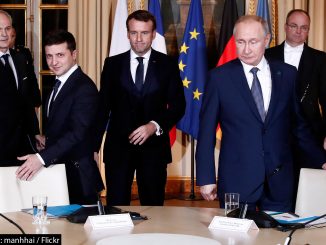For the first time since 1991, when the Baltic republics – Estonia, Latvia, and Lithuania – emerged from the Soviet Union, these states are again fearful of Russia’s intentions. After gaining their independence, these countries swiftly reoriented both economically and politically towards the West, joining both the European Union and NATO in 2004. Estonia, the wealthiest of the three, also became the seventeenth member of the Eurozone, adopting the euro as its currency. Latvia joined the Eurozone in January of this year. In view of Putin’s seizure and annexation of Crimea on the pretense of protecting the Russian-speaking elements of the population, the Baltic States, on the northwestern doorstep of Russia, are keenly aware that the same rationale could be used against them. In Latvia, Russian speakers make up some 35% of the population, and in Estonia the figure is 25%. The possibility generates less concern in Lithuania, where only 6% speak Russian and there is no border with Russia.
Given the history of these countries – in particular their experience as “captive nations” – and the weakness of the West’s responses to Putin’s moves against Ukraine (along with his earlier moves against Georgia), the fears of the Baltics are understandable. Their military forces would be no match for the Russians. Their defense would have to depend on NATO, which is committed by the North Atlantic Treaty to come to their aid, and their now-strong political ties with the European Union. I do not think Putin wants to take on NATO; to do so would be a disastrous move for his country. But he may think that the US and its NATO allies would fail to come to the defense of these small countries of little strategic importance. That would be a tragic miscalculation, in my view; but he is a gambler. It is important that the NATO members take steps to demonstrate that they stand together on this matter.
Should the Russians, contrary to our expectations, move against one or more of the Baltic States, the implications for international investors would not be attributed primarily to the effects on these three small economies. Rather, the effects, which would be very substantial, would reflect the impact on European and global markets caused by an exchange of serious economic and financial sanctions and a military confrontation between nuclear powers.
On the other hand, should the current crisis gradually de-escalate, which is our base case, global risk premia will decline and some buying opportunities could arise. There are no US-listed ETFs that provide access to the Baltic equity markets. There are MSCI equity market indices for Estonia (-6.42% so far this month) and Lithuania (+1.09% so far this month). The closest neighbors of the Baltics to the west are the Nordic countries: Finland, Sweden, Norway, and Denmark. The MSCI Nordic Countries Index is down 4.02% so far this month. There is a Global X FTSE Nordic Region ETF, GXF, which does not appear to have been affected by the tensions with Russia. It is up 1.56% over the past month, and its 12-month return is a healthy 19.9%.
Poland appears to be a better regional emerging-market proxy. Its equity market experienced a sell-off when Russia moved against neighboring Ukraine. The iShares MSCI Poland Capped ETF, EPOL, is down 5.17% so far this month and could represent a buying opportunity if the crisis de-escalates. Poland’s economy is doing relatively well, indeed better than most of Western Europe, with GDP growth approaching 3% this year. Its economic ties with Ukraine are limited.
- Bulenox: Get 45% to 91% OFF ... Use Discount Code: UNO
- Risk Our Money Not Yours | Get 50% to 90% OFF ... Use Discount Code: MMBVBKSM
Disclaimer: This page contains affiliate links. If you choose to make a purchase after clicking a link, we may receive a commission at no additional cost to you. Thank you for your support!




Leave a Reply